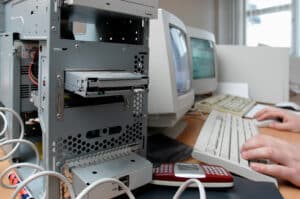What you’re risking with a legacy system – and how to manage change securely
06:07:2023
The longer a company uses an older computer system, the more risk they take on before it ultimately fails. That’s why legacy system modernization is so crucial. Whether a company is using a legacy system because of cost, data migration issues, or employees don’t want to switch to a new system, many companies put off updating their software or hardware.
All legacy systems are doomed to obsolescence sooner or later. Once they fail, they fail for good. That’s why it’s essential to adopt a new system before you reach that point. It can seem like a nearly impossible task – but it doesn’t have to be.
Here, we at SealingTech will go over what a legacy system is, what the risks are in using one and how you can successfully migrate data to a new system.
How a government legacy system holds you back

“Legacy system” or legacy platform refers to outdated, older technology that is still in use.
What is a legacy system?
“Legacy system” or legacy platform refers to outdated, older technology that is still in use — whether it be legacy software, hardware, or programming languages.
Generally, a legacy system is used because it still performs its original purpose. For example, the IRS has used a legacy system for many decades.
Why would anyone use a legacy system?
Legacy systems remain in use for several key reasons.
- Operators don’t want change. This makes sense on a practical level: Operators like what they’re used to and don’t want to have to adapt to a new system. In the worst-case scenario, they will either be unable or unwilling to modernize.
- High cost of legacy modernization. Legacy systems may be expensive to build and maintain, but the price of replacing them with a new system may be prohibitively high.
- Difficulties with data migration. The data within legacy systems may be extremely difficult to migrate to a new system. Even if an administrator wants to migrate their data to cloud computing, an older platform may not have any inherent means of accomplishing this. This is especially true if the system uses an outdated programming language that few, if any, employees know how to use.
Modernization is something you can’t ignore forever. Legacy systems will ultimately need to be replaced sooner or later. However, the longer you wait, the more apparent their limitations will become.
There are many risks associated with using legacy systems. Notably:
Security concerns

Legacy systems are at high risk of data breaches, ransomware, and other common security threats.
Legacy systems are at high risk of data breaches, ransomware, and other common security threats. This is because they’re often using outdated code, operating systems, or other features that are rife with vulnerabilities.
A large positive of modernization is the improved security that comes with it. System vendors understand well that cybercriminals are always looking for exploits in their systems to steal the data within and cause harm.
It’s also costly and time-consuming to patch an existing system when new issues are found. It can be difficult to find support for legacy systems, meaning any vulnerabilities you do find need special care outside of the manufacturer to fix.
Lack of scalability
Because an old system is built with equally outdated technologies, they inherently can’t scale as well until they undergo modernization. It can be extremely difficult, if not impossible, to expand upon an existing legacy system when there is a lack of support for it.
It is also far less feasible to implement newer technologies with legacy systems, severely limiting its capacity to expand and function. Data within a legacy system may seem difficult or impossible to transfer to the cloud because these platforms weren’t built with the cloud in mind. A legacy system can only do what it was originally designed to do.
The same security concerns also come into play. For example, how will you discover and fix potential exploits before a cybercriminal does?
Siloed teams
Siloed teams can lead to inefficiency. If teams aren’t working with each other, it becomes more difficult to meet company goals without experiencing roadblocks.
Legacy systems perpetuate siloed teams because only the teams familiar with the legacy system can use it.
Expensive maintenance
Because legacy systems have so many more vulnerabilities than new systems, patching them takes extra time and effort. There’s also always a chance that the system might fail completely, at which point you’ll need to modernize and replace it with a new system.
Customer data is more difficult to protect
Compliance laws exist for a reason: To ensure customer data is properly protected by a strict set of standards. Legacy systems may eventually not be able to meet these requirements because of their own technical limitations and inability to scale.
SealingTech can help you with legacy system modernization while avoiding the typical pitfalls you would expect to encounter.
Challenges involved with data migration

The primary concern many customers have is that their data can’t be successfully migrated into a new system.
Turning old data into new data
If you can’t successfully migrate the data, then the modernization process will fail. This is especially true if you’re using legacy software in addition to outdated technology.
The primary concern many customers have is that their data can’t be successfully migrated into a new system. It’s highly likely that an older system has data silos using outdated file types, which can add an extra challenge.
Crossing your T’s and dotting your I’s
When migrating data, it needs to be made compatible with the new system. This means transforming it in a way that the new system can understand. For example, there may be characters in the older data that the newer system processes differently.
Looking before you leap
It’s essential to test the migration of legacy data to a new system to ensure it will complete successfully. This requires taking a diverse set of sample data and attempting to transfer it. This way, you can ensure there will be no errors in the legacy system integration process because you’ve already tested the sample.
Secure Enterprise Modernization (SEM) is here to help
Sealing Technology’s Secure Enterprise Modernization (SEM) can help make the transition from a legacy system to a new system easy. By updating your systems, you’ll have a more secure, faster platform while saving on long-term costs.
We do bulk configurations, security patches and updates automatically. We also serve all areas of the world and can ship virtually anywhere.
If you’re ready to get started with modernization, contact us at Sealing Technologies today.
Related Articles
How to Set Up a Rootless GitHub Container Building Pipeline
When developing containerized applications for government customers, certain security and software requirements must be taken into consideration. The government tries to move toward Red Hat’s Universal Base Images (UBIs) to…
Defensive Cyber Operations: Cyberwarfare Explained
With the average ransom payment almost doubling from $812,380 in 2022 to $1,542,333 in 2023, and with DDoS attacks and malicious bot traffic rising, it’s even more alarming that, in…
Implementing Security Controls: An Intro to JSIG
By Walker Haddock and Spencer Shimko Occasions often arise requiring information system owners to be diligent when it comes to protecting their data and projects. Researchers feel burdened by having…
Could your new use a jolt?
Find out what’s happening across the cyber landscape every month with The Lightning Report.
Be privy to the latest trends and evolutions, along with strategies to safeguard your government agency or enterprise from cyber threats. Subscribe now.